Shar Pei
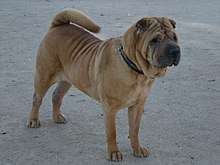 | |||||||||||||||||||||||||||||||
| Other names | Cantonese Shar-Pei | ||||||||||||||||||||||||||||||
|---|---|---|---|---|---|---|---|---|---|---|---|---|---|---|---|---|---|---|---|---|---|---|---|---|---|---|---|---|---|---|---|
| Origin | China | ||||||||||||||||||||||||||||||
| Patronage | F.C.I.[1] | ||||||||||||||||||||||||||||||
| |||||||||||||||||||||||||||||||
| |||||||||||||||||||||||||||||||
| Domestic dog (Canis lupus familiaris) | |||||||||||||||||||||||||||||||
The Shar-Pei is a breed of dog known for its deep wrinkles and blue-black tongue. The breed originates from Canton, China. The English name (沙皮, pinyin: shā pí) is probably derived from the British spelling of the Cantonese equivalent, sā pèih, which translates to "sand skin" and refers to the texture of its short, rough coat. As puppies, Shar Pei have numerous wrinkles, but as they mature, these loosen and spread out as they "grow into their skin." Shar Pei were named in 1978 as one of the world's rarest dog breeds by TIME magazine and the Guinness World Records. Although the Shar Pei has been identified as a basal breed that predates the emergence of the modern breeds in the 19th century, the American Kennel Club recognized it as their 134th breed only in 1992.[2][3]
Description

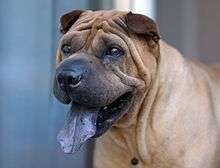
Appearance
Small, triangle ears, and a high-set tail also give the Shar Pei a unique look. For show standard, "the tail is thick and round at the base, tapering to a fine point" (AKC standard February 28, 1998). As puppies, Shar pei are a lot more wrinkly than adults and, although some adults can be wrinklier than their puppy self, an adult pei should have wrinkles mostly on the face, a few on their shoulder and at the base of the tail.
Colors
The Shar Pei's pigmentation resembles the Chow Chow as they have been crossed before, probably giving them the same blue-black tongue. There are over sixteen recognized colors in the AKC standard. The coat must be solid in color, and any Shar-Pei with a "flowered coat" (spotted) or black and tan in coloration (i.e. Rottweiler) is a disqualification. Colors include black, blue, cream, fawn, red-fawn, red, sable, apricot, chocolate, and isabella. The nose may be black or brick (pink with black), with or without a black mask. A Shar-Pei can also have what is called a "dilute" coloration, meaning the nose and nails of the dog are the same color as the coat, (i.e. chocolate coat with chocolate nose and nails). All of these color variations are acceptable, but the coat color must be solid and well blended throughout the whole body of the dog.
Coat

Horse-coat (unusual but regaining ground), rough to the touch, extremely prickly and off-standing, soft in one direction and harsh in the other; Brush-coat, with longer hair and a smoother feel; and Bear-coat (rare, and not recognized by the AKC; Bearcoats are due to the addition of other breeds). Examples of the breed were owned by the peasant class, and were used for working dogs and fighting due to their loose skin. Shar pei can be seen in Chinese art throughout history, and are considered to be one of the oldest dog breeds on earth. Western Shar Pei comes in three different coat types: horse, brush, and bear coat. The unusual horse coat is rough to the touch, extremely prickly and off-standing and is closer to the original traditional Shar Pei breed in appearance and coat type than the brush or bear coat. This coat is fairly prickly and can be rough or irritating when petting in the opposite direction of the fur. The horse coat is generally thought to be more active and predisposed to dominant behavior than the brush coat. The brush-coated variety have slightly longer hair and a smoother feel to them. The brush coat is generally considered to be more of a "couch potato" than the horse coat.
This breed sheds normally twice a year.[4]
The Chinese Shar-Pei is a unique and intelligent dog most often recognized for its wrinkles. Initially developed as a Chinese farm and hunting and later fighting dog, the breed does well today in obedience, agility, herding and tracking, with skills that would have been needed on the farm. Because the name Shar-Pei means "sand coat", harshness is a distinctive feature in its two accepted coat types, either horse (short) or brush (up to an inch long). Other unique qualities include black mouth pigment, a slightly "hippo-like" head shape, small ears, deep-set eyes and rising top-line.
Any coat longer than one inch at the withers is called a "bear coat" and is not considered breed standard, as it occurs only when both the male and female carry recessive coat genes. This coat length resembles the coat of the Chow Chow and was probably inherited from the chows. The personality of the bear coat is very much like that of a brush coat.
Wrinkles
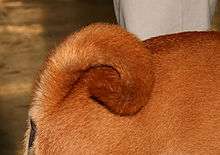
The traditional Shar Pei that is most popular in China is more faithful to the history of the breed (taller, less wrinkly, flatter mouth and nose, horse coated). As puppies, they have lots of wrinkles and as they get older, they get fewer wrinkles.
Scientists from the Department of Genome Sciences at the University of Washington, Seattle, announced in January 2010 that they had analysed the genetic code of 10 different pedigree dog breeds. In the Shar-pei, they discovered four small differences located in the gene HAS2 which is responsible for making hyaluronic acid synthase 2. That enzyme makes hyaluronic acid, which is one of the key components of the skin. There have been rare cases in which a mutation of the same gene has caused severe wrinkling in humans as well.[5]
Temperament
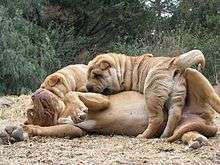
All Shar-Pei puppies need early socialization with children, strangers, and other animals. Some people may experience a sensitivity to the harshness of the coat of either length. This is a mild, short-lived rash that can develop on the skin that has been in contact with the coat, most common on the forearms.
The Shar Pei is often suspicious of strangers, which pertains to their origin as a guard dog. It is a very independent and reserved breed. Nevertheless, the Shar Pei is extremely devoted, loyal and affectionate to its family and is amenable to accepting strangers given time and proper introduction at a young age. If poorly socialized or trained, it can become especially territorial and aggressive. Even friendly and well-socialized individuals will retain the breed's watch dog proclivities (like barking at strangers). It is a largely silent breed, barking only when it is playing or worried. The Shar-Pei were originally bred as palace guards in China. Although Shar-Pei are sometimes stubborn, they are receptive to fair, compassionate training. With repetition and a clear reward system, training is not very difficult, however they do not respond well to negative and cruel treatment. The Shar Pei can be a dog that is loyal and loving to its family while being very protective. Shar-Pei do not like to be alone, preferring to be close to their humans, often lying nearby in the same room.
Health
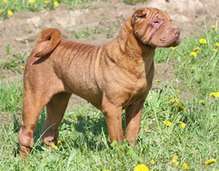
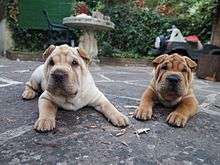
Because of its popularity after being introduced to North America in the 1970s, the breed suffered much inexperienced or rushed breeding. This resulted in not only a dramatically different look for the Shar-Pei (as its most distinctive features, including its wrinkles and rounded snout, were greatly exaggerated), but also a large number of health problems. The American breed club states that few Shar Peis make it to age 10 and has a longevity program that records dogs that live 10 years or more.[6]
Compared to other breeds, Shar Peis have increased risk of developing atopic dermatitis, a chronic allergic skin disease.[7] Dogs with allergic skin disease often get allergy-induced skin infections.[8] Shar Peis are also at increased risk of demodicosis,[9] a disease which happens when Demodex canis mites proliferate and cause skin irritation, inflammation and infection.[10]
Familial Shar Pei fever (FSF) is a serious congenital disease that causes short fevers lasting from 24 hours, sometimes up to three days and usually accompanied by accumulation of fluid around the ankles (called Swollen Hock Syndrome). Amyloidosis, a long-term condition, is most likely related to FSF, caused by unprocessed amyloid proteins depositing in the organs, most often in the kidneys or liver, leading eventually to renal failure. The disease is associated with the western type and it is estimated that 23% are affected.[11] The Australian breed standard was changed in 2009 to discourage breeding for heavy wrinkling.[12]
A common problem is a painful eye condition, entropion, in which the eyelashes curl inward, irritating the eye. Untreated, it can cause blindness. This condition can be fixed by surgery ("tacking" the eyelids up so they will not roll onto the eyeball for puppies or surgically removing extra skin in adolescent and older Shar Pei).[13] In Australia, more than 8 in 10 Shar Peis require surgery to correct eye problems,[14] contributing to them being the most expensive breed to insure.[15]
The Shar-Pei is also prone to chronic yeast infections in its ears. This is due to tight inner ear structure with a wrinkled appearance, making cleaning very difficult; exacerbated by the tight "flap" that the ear creates over the canal, promoting a moist environment.
Vitamin B12 deficiency is a common problem in the Shar Pei and is suspected to be hereditary.[16][17]
History
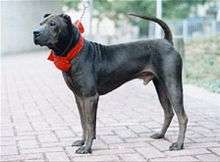
The Shar Pei has been identified as a basal breed that predates the emergence of the modern breeds in the 19th Century.[18] According to historical documents and artifacts, they have existed in China since ancient times, and their likeness was often used to decorate various objects, especially during the Han Dynasty. During this period, they were used as fighting dogs, and gradually became favorite pets of Chinese emperors. They continue to be trained as fighting dogs in modern-day Tibet.[19]
The Shar Pei breed comes from the Guangdong province of China. The original Shar-Pei from China looked very different from the breed now popular in the West. People in southern China, Hong Kong, and Macau differentiate the Western type and the original type by calling them respectively 'meat-mouth' and 'bone-mouth' Shar-Pei.
The Shar Pei's loose skin and extremely prickly coat were originally developed to help the dogs fend off wild boar, as they were used to hunt. Later, the breed was used for dog fighting; these enhanced traits made the Shar Pei difficult for its opponent to grab and hold on to, and so that if it did manage to hold on, the Shar Pei would still have room to maneuver and bite back; when grabbed by any loose wrinkle, a Shar Pei can actually twist in their skin and face in their opponent's direction. In fighting, they would twist in their skin to bite the assailant back.
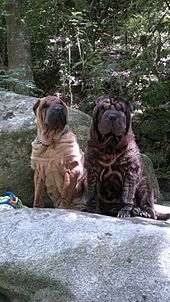
During the Communist Revolution, when the Shar Pei population dwindled dramatically,[20] dogs were rescued by a Hong Kong businessman named Matgo Law, who in 1973 appealed to Americans through a dog magazine to save the breed.[21] Around 200 Shar Peis were smuggled into America. The current American Shar Pei population stems mainly from these original 200.
Famous Shar Pei's
Pussy is a British Shar Pei born in August 2012 who lives in California and has modeled for Piaget, De Beers and Chopard appearing in publications including Haper's Bazaar.[22]
See also
- List of dog fighting breeds
- Foo Dog, dog breeds originating in China that resemble Chinese guardian lions and hence are also called Foo or Fu Dogs or Lion Dogs
References
- ↑ Fédération Cynologique Internationale Standard Archived 2003-03-18 at the Wayback Machine. No. 309 of April 14, 1999, translated August 9, 1999, retrieved 2009-04-12 (in English)
- ↑ Information from the American Kennel Club
- ↑ "Chinese Shar-Pei: Did You Know?". American Kennel Club. Retrieved 2017-11-05.
- ↑ Go Pets America: Dogs that do not shed – Retrieved September 7, 2008
- ↑ Amos, Jonathan (2010-01-12). "Shar-pei wrinkles explained by dog geneticists". BBC News. Retrieved 2010-01-12.
- ↑ Libman, Roberta. "CSPCA Longevity Program". Chinese Shar-Pei Club of America. Retrieved 14 August 2014.
- ↑ Mazrier, Hamutal; Vogelnest, Linda J.; Thomson, Peter C.; Taylor, Rosanne M.; Williamson, Peter (June 2016). "Canine atopic dermatitis: breed risk in Australia and evidence for a susceptible clade". Veterinary Dermatology. 27 (3): 167–e42. doi:10.1111/vde.12317.
- ↑ Saridomichelakis, Manolis N.; Olivry, Thierry (January 2016). "An update on the treatment of canine atopic dermatitis". The Veterinary Journal. 207: 29–37. doi:10.1016/j.tvjl.2015.09.016. PMID 26586215.
- ↑ Plant, Jon D.; Lund, Elizabeth M.; Yang, Mingyin (February 2011). "A case-control study of the risk factors for canine juvenile-onset generalized demodicosis in the USA". Veterinary Dermatology. 22 (1): 95–99. doi:10.1111/j.1365-3164.2010.00922.x.
- ↑ Koch, Sandra N. (January 2017). "Dermatology details: Updates on the management of canine demodicosis". Today's Veterinary Practice. 7 (1): 77–85. Retrieved 2017-01-26.
- ↑ Olsson, M.; Meadows, J. R. S.; Truvé, K.; Rosengren Pielberg, G.; Puppo, F.; Mauceli, E.; Quilez, J.; Tonomura, N.; Zanna, G.; Docampo, M. J.; Bassols, A.; Avery, A. C.; Karlsson, E. K.; Thomas, A.; Kastner, D. L.; Bongcam-Rudloff, E.; Webster, M. T.; Sanchez, A.; Hedhammar, A.; Remmers, E. F.; Andersson, L.; Ferrer, L.; Tintle, L.; Lindblad-Toh, K. (2011). Georges, Michel, ed. "A Novel Unstable Duplication Upstream of HAS2 Predisposes to a Breed-Defining Skin Phenotype and a Periodic Fever Syndrome in Chinese Shar-Pei Dogs". PLoS Genetics. 7 (3): e1001332. doi:10.1371/journal.pgen.1001332. PMC 3060080. PMID 21437276.
- ↑ Murphy, Bridget (18 March 2011). "How Shar-Pei dogs got their wrinkles". Cosmos. Retrieved 18 April 2011.
- ↑ Gelatt, Kirk N. (ed.) (1999). Veterinary Ophthalmology (3rd ed.). Lippincott, Williams & Wilkins. ISBN 0-683-30076-8.
- ↑ Ryan, Kelly (18 April 2011). "Wrinkly dogs get nip and tuck". Herald Sun. Retrieved 18 April 2011.
- ↑ "What is the Most Expensive Breed of Dog to Insure In Australia". Top10 Pet Insurance. 28 April 2017.
- ↑ Grützner, Niels; Bishop, Micah A.; Suchodolski, Jan S.; Steiner, Jörg M. (1 March 2010). "Association Study of Cobalamin Deficiency in the Chinese Shar Pei". Journal of Heredity. 101 (2): 211–217. doi:10.1093/jhered/esp100. ISSN 0022-1503. PMID 19926684. Retrieved 5 November 2016.
- ↑ Bishop, Micah A.; Xenoulis, Panagiotis G.; Berghoff, Nora; Grützner, Niels; Suchodolski, Jan S.; Steiner, Jörg M. (1 January 2012). "Partial characterization of cobalamin deficiency in Chinese Shar Peis". The Veterinary Journal. 191 (1): 41–45. doi:10.1016/j.tvjl.2011.05.008.
- ↑ Larson, G (2012). "Rethinking dog domestication by integrating genetics, archeology, and biogeography". Proc. Natl. Acad. Sci. U.S.A. 109: 8878–83. Bibcode:2012PNAS..109.8878L. doi:10.1073/pnas.1203005109. PMC 3384140. PMID 22615366.
- ↑ "Shar Pei". 2puppies. Retrieved 5 November 2016.
- ↑ "History". American Kennel Club. Retrieved 24 January 2015.
- ↑ Ditto, Tanya B. (1992). Vriends, Matthew M., ed. Shar-Pei: Everything about purchase, care, nutrition, breeding, behavior, and training. Hauppauge, NY: Barron's Educational Series. p. 5. ISBN 9780812048346.
- ↑ "Lessons in Shine: Diamond Collars". Harper's BAZAAR. 2016-03-29. Retrieved 2018-10-11.
External links
| Wikimedia Commons has media related to Shar-Pei. |
- Shar Pei at Curlie (based on DMOZ)
- More on the traditional Bone-mouth Shar-pei